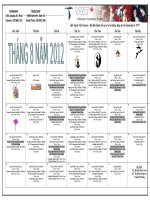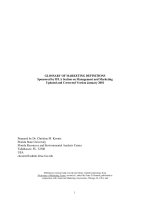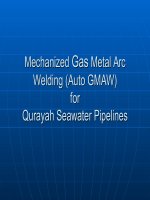05Welding processes2 GMAW updated
Bạn đang xem bản rút gọn của tài liệu. Xem và tải ngay bản đầy đủ của tài liệu tại đây (197.65 KB, 12 trang )
Welding Processes – 2. GMAW/MIG/MAG
1. Principle
2. Operating Modes
3. Advantages and Limitations
4. Application and positional capabilities
5. Weld able Metals and Thickness Range
6. Joint Design
7. Welding Circuit and Current
8. Equipment
9. Consumables – Electrodes and Shielding Gases
10. Deposition Rates, Quality Control and Trouble Shooting
11. Weld Schedules
Welding Processes – 2. GMAW / MIG / MAG
1.1 Principle
Metal inert gas (MIG)/metal active gas (MAG)
welding is a fusion welding process that joins
metals by melting them with an arc which is
formed between a continuous filler wire electrode
and the work piece.
An externally supplied shielding gas normally
provides atmospheric protection of the molten
weld pool. MIG/MAG welding is also known as
gas-shielded metal arc welding.
The MIG/MAG process is often referred to as semiautomatic welding when the torch is
hand-held because the consumable wire is fed mechanically and the power source
normally regulates the arc length; the only manual control required during welding by
the welder for semiautomatic operation are the travel speed, and gun positioning and
guidance. The operator is therefore not concerned with controlling the arc length
(compared with MMA) and can concentrate on depositing the weld metal in the correct
manner. The process can also be mechanised or applied using a robot.
Welding Processes – 2. GMAW / MIG / MAG
1.2 Operating Mode – Most popular mode is semiautomatic. Second is the fully
automatic. The process can be applied as mechanized. The process can not be used
manually.
Power supply is normally CV type.
Only DC operation (AC not used). DCEP is the normal mode of operation. DCEN
rarely used with some specific electrodes.
1.3 Advantages and Limitations
Most popular welding process now. High deposition rates, High operator factor,
High utilization of filler metals, no slag/flux, less smoke and fumes, lower operator
skill level, easy automation etc
Position - All positions
Limitations include lower accessibility, difficulties with soft electrodes (spool gun
feeder), expensive equipment, sensitivity of gas shielding to wind drafts.
Welding Processes – 2. GMAW / MIG / MAG
1.4 Common Applications and Positional Capabilities
An all position process.
Different variations have their own Positional capabilities depending upon
electrode size and type of metal transfer.
Mainly sheet metal and piping industries. Many other applications such as
Aluminium bus bars in electrical industries.
Welding Processes – 2. GMAW / MIG / MAG
CO2 Welding, Large Electrodes Flat, Horizontal
Spray Arc Flat, Horizontal
Spray Arc-Small Electrode Vertical, OverHead
Short Circuit All Position
Pulsed Spray All Position
1.5 Weldable Metals and Thickness Ranges
Thickness – Wide thickness ranges (0.13 mm upwards, from thinnest to thickest)
Metals – Wide range of metals (most metals can be welded). CO2 welding is
restricted to steels.
1.6 Joint Design
Similar joint details as SMAW. Smaller groove angle mean better economy and
efficiency.
1.7 Welding Circuit and Current
The wire feeding system controls the electrode wire feed and welding arc, as well
as the flow of shielding gas and cooling water.
Self stabilization Characteristics of GMAW
Welding Processes – 2. GMAW / MIG / MAG
1.8 Equipment
A direct current DC output is normally required. Conventional GMAW power
sources have constant voltage (CV) output characteristics. The slope is different
according to process requirement.
Welding Processes – 2. GMAW / MIG / MAG
1.9 Consumables – Electrodes and Shielding gases
Selection of electrode depend upon metal to be welded, thickness and joint design,
surface condition, specifications or service conditions.
AWS designation system for Solid Wires
Selection of shielding gases for MIG/MAG welding is primarily dependent on the
material type and metal transfer mode (and hence material thickness).
The main gases and gas mixtures used for carbon and low alloy steel welding are
CO
2 , Ar-CO2 and Ar-O2.
Some mixtures may also contain a proportion of helium in substitution for argon.
Welding Processes – 2. GMAW / MIG / MAG
1.10 Deposition Rates , Quality Control and Trouble Shooting
Deposition rates are higher for same welding current than for SMAW. The welding
procedure, electrode size and CTWD all effect the deposition rate.
A low hydrogen process.
Quality of welds can be very high.
Quality depends on electrodes, cleanliness, procedure, position and skill of welder.
Quality also depends on efficiency of shielding envelope
Welding Processes – 2. GMAW / MIG / MAG
1.10 Deposition Rates , Quality Control and Trouble Shooting
Welding Processes – 2. GMAW / MIG / MAG
1.10 Deposition Rates , Quality Control and Trouble Shooting
Welding Processes – 2. GMAW / MIG / MAG
1.11 Welding Schedules
Welding Processes – 2. GMAW / MIG / MAG









